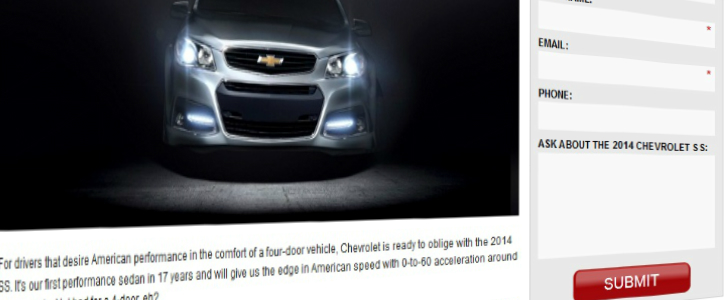
We’ve all heard about how inbound marketers need to get more creative with their content format by incorporating visuals, audio, and images. Heck, we’ve even created a free crash course (with templates) for non-designers tocreate visual content to react to this trend. With all these content types, aren’t we forgetting something?
Oh right. SEO. Even with the new glasses, Google still can’t read and index images, video, and audio content without a little help. Luckily, we have everything you need to know about SEO for non-written content, from images, to video, to audio content. Let's dive in, shall we?
Best Practices for Image SEO
To explain this concept, let's take a step back and imagine we're proprietors of a tasty ice cream shop. You've just created an infographic about the most popular ice cream flavors and toppings, and now you want to ensure it's optimized to show up in Google. Here's what you do.
1) Pick an image that's in a Google-supported format.
Before uploading your beautiful ice cream infographic, make sure it’s in the right format. Google can only index images that are saved as BMP, GIF, JPEG, PNG, WebP, and SVG. Don’t worry if your image isn’t in that format yet -- most image editors have the capability to save the file as a GIF or JPEG.
2) Name the file using keywords that describe the image.
Raise your hand if you have uploaded an image with a name like "IMG12934.jpg." (Guilty.) Instead of giving search engines a title that has nothing to do with the image, rename the file with a keyword phrase that describes what the image is. Google uses these filenames to index those images and sometimes the file name can even show up as the image title in a SERP. For this infographic, you might try a phrase like, “Popular-Ice-Cream-Flavors-Infographic.jpg”. Isn’t that better? Google thinks so, too. Don't forget to separate words with dashes--Google sees dashes as word separators and underscores as word combiners.
3) Add in helpful alt text.
The alt text of an image not only helps the search engines understand what the content of the image is so they can match it to a relevant search query, but it helps any searchers who can’t view the image understand what they would be looking at. Be as descriptive as possible in your alt text ... without keyword stuffing. Here’s a bad, better, best example for the ice cream example to see what I mean.
- Bad: alt=””
- Better: alt=”Ice cream”
- Best : alt=”Popular ice cream flavors”
- Avoid: alt= “ice cream flavor yummy vanilla chocolate Delicious"
4) Provide context for the image within content.
Remember, your image doesn’t live separately from the rest of your on-page content! Help search engines get a better sense of the story your page tells by referencing the image within your written content. Within your blog post, you might write something like, “On our popular ice cream flavors timeline to the left, you can see that cake batter is one of our newest flavor experiments.” See how I used the same keywords from the file name and alt text, but made it easy for the viewer to read? That’s an SEO win/win/win my friends.
5) Submit an image sitemap.
To make extra-super-sure that your ice cream flavor timeline is indexed by Google, submit an image sitemap to Google Webmaster. Sound scary? Don’t worry. Sitemaps are just an xml file that tells Google about a page on your website it might not discover -- the most simple sitemaps usually list the pages on your website. To create an image sitemap, add image-specific tags to a sitemap or just update one of your existing sitemaps with image tags. We’ll go more into making a sitemap in the video section, but here is exactly how to create and submit an image sitemap to Google.
Best Practices for Video SEO
Now that you’ve got the image basics down, it’s time to tackle video. MarketingSherpapublished a case study that found that videos attract 200-300% more monthly unique visitors who spend twice as long on-site. Sounds good to me! Let’s continue the dessert example, and pretend you want to embed a video on the recipes page with one of your chefs explaining how he makes your famous red velvet cupcakes (am I making you hungry yet?).
1) Save your video in a format that Google can crawl.
Like images, there are only some file formats that Google can read. Make sure your video is saved as a MPG, MPEG, M4V, MOV, WMV, ASF, AVI, RA, RAM, RM, FLV, or SWF. Most video editors will allow you to save your video in different formats.
2) Name your video file strategically.
Just like naming images, save your video file as a name that accurately describes what the file is within the context of the article without keyword stuffing. Luckily, this one is easy. Just save the video with a contextual keyword-appropriate title, like “Red-velvet-cupcake-recipe”.
3) Embrace your keyword strategy in your title, tags, and video meta-description.
You probably guessed it from the images section, but your title, alt text, and meta description should all help search engines understand what the content of your video is. However, keyword strategy from a user perspective is extra important here -- video is very likely to be viewed and searched independent of your website.
Your video title should reflect the keywords that your users are searching for, and that, of course, align with your video's content. Not sure what those are? Use a keyword tool to see what words and phrases people are searching to find your website.
Keywords are especially important to the description you provide for the video. In YouTube, you have up to 5,000 characters to describe your video. Since Google will cut off this description on the SERP to 156 characters, make sure your first sentence includes the keywords you’re optimizing for, but also gives the viewer a reason to click through. Then, continue your description with keywords and context that will help Google understand what your video is about. Finish off the description with alt text, or tags, that help paint a fuller picture for search engines.
4) Try to host only one video per page.
Your website may have a page that acts as a whole archive for its videos. This type of library can be extremely helpful for reference purposes, but from a search engine perspective, it's only a good idea if all the videos are about the same general topic. For instance, you might house all of your recipes videos on one page that's optimized to show up for a query like "dessert recipe videos." But if you want to get more granular, let's say getting found for your series on how to make cupcakes, you might want to create a separate page for videos that would ideally turn up around "cupcake recipe videos."
5) Enable sharing with embedding and specific anchor text.
Social sharing plays a role in SERP rankings for a specific keyword phrase. The Google update story can get complicated with Pandas and Penguins and the like, but one takeaway can be boiled down to four little words: more shares, better rankings. The more people embed your video in their own blog posts or share it on social media, the more the search engines love you (or your content, rather). Help your red velvet cupcake recipe video spread like wildfire by making sure the video is easily embeddable. The option to allow embedding is available on most video hosting services.
6) Create and submit a Video Sitemap to Google Webmaster.
Make sure your video is indexed by Google by submitting a video sitemap to Google webmaster. Like I said in the images section, Sitemaps are XML files with a site’s meta data that inform search engines about pages on their site that are able to be crawled. Bonus points -- submitting a video sitemap to Google Webmaster also encourages Google to include a rich snippet with your video on the SERP.
For the full story on creating and submitting a video sitemap, go straight to the source onGoogle’s Webmaster blog.
7) Include a transcription.
Sometimes, the best way for search engines to index non-written content is to make it written content by adding a transcription. Most video services, including YouTube and Wistia, include transcription services for free or for a small fee. Include a transcription on your page to help search engines and viewers who can’t watch now better consume your content. Even better? Once you have a transcription, you can repurpose that written content into another ebook or blog post. That red velvet cupcake recipe video transcription could easily be added to a recipe ebook with minimal effort or edits.
Best Practices for Audio Content SEO
We’ve talked a lot about optimizing images and videos for search engines, but what about audio content, like podcasts? Just like Google doesn’t have eyes to view images or video, search engines also don’t have ears to listen in on your audio. But there are still ways to make sure that search engines hear the message. Since all those ice cream flavors and cupcake recipes have got me wanting to cheat on a diet, let’s make this podcast “How to Enjoy Desserts You Love Without the Guilt”.
Many of the SEO standards we discussed for images and video apply here for Google: alt-texts, titles, descriptions, and a unified keyword presence are all relevant for users to find your podcast on Google. However, when people are looking for podcasts, they primarily head to iTunes. To rank high in the iTunes podcast SERP (which often translates to better search engine ranks as well), here are some specific areas to hone in on.
1) Make your podcast easily navigable from the iTunes SERP.
Here’s a quick test to make sure you’re as easily found as you think you are: Work backwards from a viewer who has never heard of your podcast, but is searching for similar content. In this case, try searching “easy exercise tips” or a similar keyword phrase on iTunes. The process of typing in a search into the iTunes store, finding the podcast website, determining the podcast content, and listening and subscribing to your content should be easy as pie for the listener. By testing your own podcast from the beginning, you can identify hiccups from the user experience angle.
2) Optimize your content for strategic keywords.
Like video, keyword strategy is one of the most important parts of optimizing your podcast. Remember your keyword strategy when naming your podcast, episodes and writing descriptions. Research non-competitive keywords that match your content using a keyword tool.
3) Accrue subscribers.
There’s a difference between listeners who play your podcast once, and subscribers who sign up to automatically download a new episode whenever it comes out. When ranking keyword phrases, iTunes favors podcasts with more subscribers -- a higher percentage of subscribers communicates that your podcast is consistently valuable. Accrue subscribers by making it as painless as possible to subscribe (ideally with just a click of a button). Encourage listeners to take the next step to subscribe by clearly outlining the value proposition of your podcast, and include action verbs that encourage people to sign up now.
4) Solicit reviews.
iTunes also tends to favor podcasts with more reviews in their SERP. Podcasts with a higher volume of reviews indicate higher engagement. Ask listeners and subscribers directly for reviews. Include a review CTA at the end of every episode and on your podcast web page. Call out specific reviews in your podcast to show that you're listening to what your listeners and subscribers are saying. Check social media to see if there are listeners who frequently talk about your content and approach them for a product review.
5) Factor in the age of your podcast.
Another factor iTunes takes into account in their rankings is the age of your podcast. Podcasts that have been around longer are more likely to rank higher than newer ones. While there isn’t a lot you can do to manipulate the age of your podcast, the age factor is worth keeping in mind when you're considering starting an additional podcast.
6) Include a transcription.
There are plenty of services, like Casting Words, that will transcribe your podcast for as little as a dollar a minute. Translate your audio content into a written format to better help search engines and listeners digest your content, and to make it easier to repurpose that content for future use.
Best Practices for Non-Written SEO in Social Media
We’ve gone over what the SEO best practices are for individual non-written content assets, but how do those practices change within the context of social media? If you didn't already know, the two are kind of connected. And with social networks becoming more visual, optimizing non-written content is more important than ever.
But let me be clear -- the goal for non-written SEO in social networks isn’t necessarily to be found by search engines, but to make sure you’re using non-written content to its full advantage. Here are some resources for non-written SEO best practices for specific social networks. For a more general overview on optimizing your social media presence, here’s theultimate guide to optimized social media updates.
Pinterest
Since Pinterest is an image-centric network and has just come out with analytics, we thought thatSEO for Pinterest was an article all in itself. Best practices include the following if you're looking for the short synopsis:
- Optimize your account name and description.
- Include links back to your website on every pin.
- Use keywords in the filename and alt text of images you pin.
- Take time with each pin’s description to describe the image and include keywords.
- Incorporate hashtags to amplify the social reach of your pins.
For more details, read this article on everything you need to know about optimizing your Pinterest account.
Facebook
We have original data that indicates photos on Facebook generate 53% more likes than average posts. Images and videos are obviously a huge part of encouraging fans not only to interact with your brand, but also consume content that moves them down the funnel, especially now that Facebook updated its cover photo guidelines to include CTAs. Read this easy-to-follow tip sheet to find the best ways to engage your Facebook fans with images that breaks down thebest practices for Facebook cover images and albums.
Twitter
Twitter is buzzing with new image and multi-media updates. The biggest integration Twitter has with multi-media content is the new Vine video app. With Vine you have the opportunity to:
- Optimize cover photos on brand pages and include CTAs within your profile
image.
- Showcase multi-media content with featured tweets.
- Identify what keywords your account should focus on.
- Create a Vine account and incorporate it into your video strategy.
- Measure the ROI of Vine and Twitter to optimize conversions and reach.
Google+
The most important thing to think about with Google+ SEO is authorship. Having the author image next to an article’s listing in the SERPs makes it much more clickable than plain text. Here’s a more in-depth article that explains why Google+ authorship is important, and how to apply for it.
What are some of the best practices you use when optimizing non-written content for SEO? Got any great tips to share? Let us know in the comments section!
Image credit: starmist1
Source - http://blog.hubspot.com/search-engine-optimizing-non-written-marketing-content















